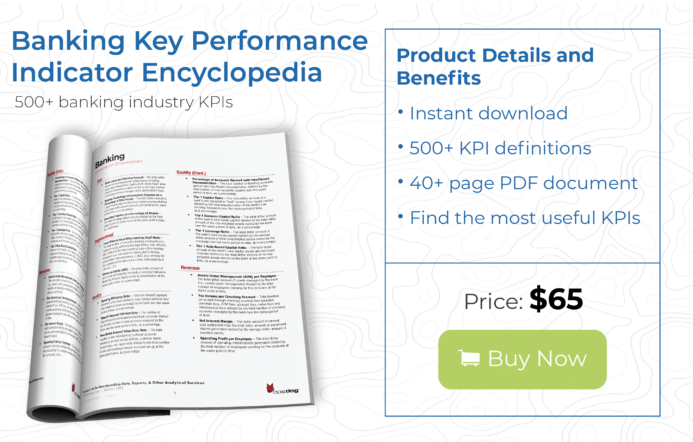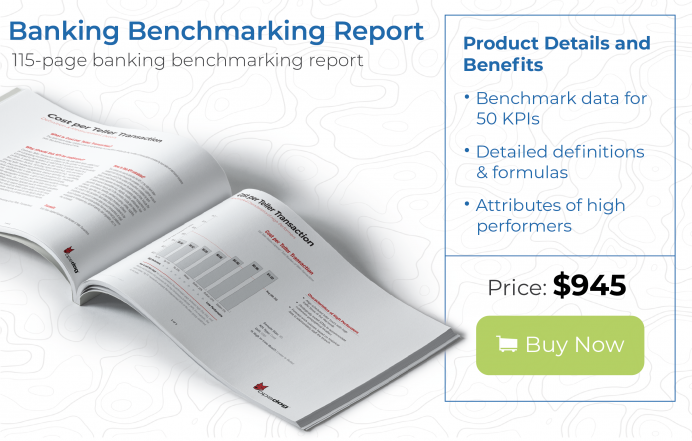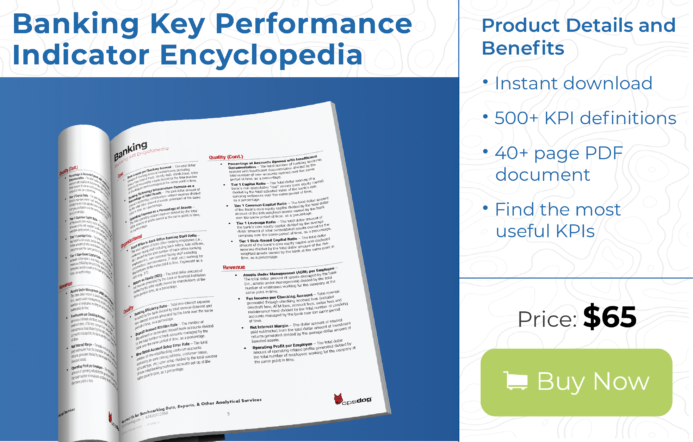While customers are increasingly adopting online and mobile banking, many still prefer the branch for opening accounts or for big-ticket transactions like mortgages. Brick-and-mortar branches also provide one of the best opportunities for banks to deepen their customer relationships, cross-sell products and services, and build their brand.
Retail branches will continue to play an important role for banks in acquiring accounts and serving customers, but banks will need to tweak and refine their branch strategies to deliver a better customer experience while keeping operating costs in check. However, as one of the costliest delivery channels, it makes sense to monitor branch performance metrics closely to ensure that each branch is delivering value, running efficiently, and meeting overall bank objectives to increase its revenues and asset base.
What are Bank Branch Performance Metrics?
A bank branch performance metric is a quantifiable measurement that assesses and tracks a specific process that occurs in a brick-and-mortar location. Metrics can measure everything from how long it takes tellers to complete transactions to how long customers wait in the lobby. These metrics are crucial in keeping bank executives, branch managers, operations teams, marketing and sales, finance, and other stakeholders informed in how both individual employees, individual branches, and the entire branch network are performing.
Types of Bank Branch Performance Metrics
Bank branch performance metrics can span many different areas of measurement. However, banks should not look at metrics in isolation. For example, a bank that focuses on reducing the amount of time it takes tellers to complete a transaction may find that its customer relationships suffer because tellers are rushing through transactions. Instead, banks should take a more balanced approach to implementing bank performance metrics by using a variety of metrics to meet its overall long-term business objectives.
There are four types of bank branch performance metrics:
- Productivity – Examines the effectiveness of a bank branch process, these key performance metrics for banks are usually measured in output in relation to input.
- Quality – These metrics focus on how efficiently certain processes are being performed.
- Service – These bank branch performance metrics focus mainly on customer satisfaction, bridging customer needs to internal processes.
- Cost – Keeping costs low is integral to any bank branch location, making these metrics very important to track, but not at the expense of other metric types.
How Banks Can Use Branch Performance Metrics
Bank branch performance metrics enable banks to identify the strengths and challenges of its branch network and improve performance by tweaking staffing, hours of operation, and even recalibrating its branch footprint. Metrics can also inform changes in branch employee roles and responsibilities to drive greater efficiency.
The metrics that are important for one bank may not be appropriate for the branch down the street. Branch performance metrics should always be closely aligned with the bank’s overall business strategy and brand.
While banks can apply bank performance metrics to almost any branch process, they will also need to ensure that they will be able to collect those metrics. In the best case scenario, existing processes and systems will support easy collection. If not, the bank will need to develop a plan and possibly implement technology tools to capture the data.
Benefits of Branch Performance Metrics
Banks can use branch performance metrics to build awareness and insights into what measurements are most important for the business and how those metrics can support the overall bank strategy. The most critical metrics rise to the top based on the banks’ goals and long-term objectives. And since the performance metrics can be applied uniformly across the entire branch network, banks have a way to more accurately and consistently analyze individual branch performance.
Having quantifiable performance metrics also gives the bank’s stakeholders a common ground for discussing critical issues impacting branch performance and developing a plan for improvement.
Examples of Performance Metrics for Branches
Any branch process can be measured. However, here are a few of the most widely used branch performance metrics:
Bank Branch Performance Indicator #1: Deposit Accounts per Transaction Processing and Support Employee
It can be easy to over or even underestimate the capacity of the back office in regards to time spent on various accounts. The more accounts that a transaction processing employee can manage, shows that time is being managed well in the back office. Use this metric to measure the total number of deposit accounts divided by the number of back office transaction and support employees.
High values are preferable for this bank performance metric since they indicate effective time management skills and the ability of an employee to prioritize customer facing tasks. Lower values can point to lower production levels and can place a burden on bank branch cost structures. A bank branch might consider additional training in cross-selling processes to increase new account sales per employee.
Bank Branch Performance Indicator #2: Retail Branch Span of Control
Curious as to the average number of branch employees reporting to each branch manager? This metric is heavily dependent on the organizational structure of the bank in question. Highly structured bank branch organization will typically have lower numbers, flat organization will have the opposite. A mid-range value for this metric is desirable, too high or too low a value can lead to issues within the hierarchy.
For example, a high span of control (more employees per branch manager) can keep staffing costs low, it could also indicate that managers are spread too thin and employees are not being trained, coached, and developed for growth and increased responsibilities. A low span of control can mean there are redundant or unneeded management positions.
Bank Branch Performance Indicator #3: Teller Transaction Cycle Time
No customer enjoys standing in line. Even worse would be finally getting to the front, only to have their transaction take much longer than they anticipated. This retail branch key performance indicator is measured by the average amount of time, measured in seconds, required for a customer to complete a transaction with a branch teller.
Long transaction times can indicate ineffective teller training, lack of on-the-job aids, or reliance on outdated or ineffective technology. Extended transaction times can negatively impact customer service, employee productivity, and morale. Aim for short transaction times by identifying which areas of the process are slowing down cycle times and standardize customer transactions as much as possible.
Bank Branch Performance Indicator #4: Average Retail Branch Lobby Wait Time
A fundamental measurement of customer service levels, this metric helps banks understand foot traffic and staffing levels in the branch. If the branch is understaffed at peak hours and overstaffed at slow periods, this will negatively affect customer satisfaction and the bottom line. Measure this bank performance metric by calculating the average amount of time a customer must wait before meeting face-to-face with a non-teller retail branch service representative.
Wait times should be low, but not too low. Long wait times may negatively impact customer service and sales and could be due to a lack of staff training and experience, outdated and inefficient processes and technology, or a lack of communication regarding branch customer walk-ins. Non-existent or extremely short wait times may indicate overstaffing or a reduction in foot traffic that could support decreased staffing.
Bank Branch Performance Indicator #5: Transactions Processed per Teller
This key performance indicator for retail branches measures the productivity and efficiency of a group of branches and/or tellers and the productivity and efficiency of an individual branch and/or teller. If it found by calculating the total number of teller transactions (deposits, withdrawals, money orders, etc.) divided by the number of tellers working.
A retail branch wants its tellers to be productive, therefore a high value for this metric is preferred. Low productivity could indicate inefficient transaction processes, lack of training and job aids, or overstaffing. To keep this metric high be sure to align tellers hours with high traffic hours and dedicate training time to improve any teller weaknesses.
Bank Branch Performance Indicator #6: Cost per Teller Transaction
Highly manual transactions, filled with errors and prone to rework, can cause costs to inflate. These processes such as manual data entry or document management need to be re-examined to ensure that they aren’t a sinkhole for costs. Start by measuring the total teller cost divided by the number of transactions completed. Then dive deeper into what could be causing the rising costs of each transaction.
A high cost per teller transaction could indicate more than just highly manual processes, it could also point to overstaffing, poor management, or inadequate teller training. A knee-jerk reaction is to reduce headcount to lower the cost per transaction, but this can backfire and impact customer satisfaction and employee morale. Lower costs by forecasting work volumes based on historical data to appropriately staff the bank and provide training and job aids for all tellers.
Final Thoughts
Bank branch performance metrics provide a quantifiable measurement of branch productivity, quality, service, and costs. Using these metrics, banks can make changes to how they think about and support the branch and its employees. While banks can measure the performance of literally hundreds of processes, it’s more advantageous to begin with a few metrics that are closely aligned to the banks’ top strategic priorities. Once the bank has used those metrics to take action and improve processes, it can build on that success to implement additional performance metrics.
Interested in automating your banking back-office? Find out how to achieve successful automation here!
If you are looking for a full list of bank branch performance metrics download our Banking Key Performance Indicator Encyclopedia here.
If you need more help benchmarking your retail bank branch against your peers then help yourself to our presentation-ready Banking benchmarking reports, or contact us for more information concerning our Benchmarking Research and business intelligence implementation services. We’ll quickly help you benchmark your bank branch business and provide you with high-quality presentation-ready deliverables at an affordable price.





